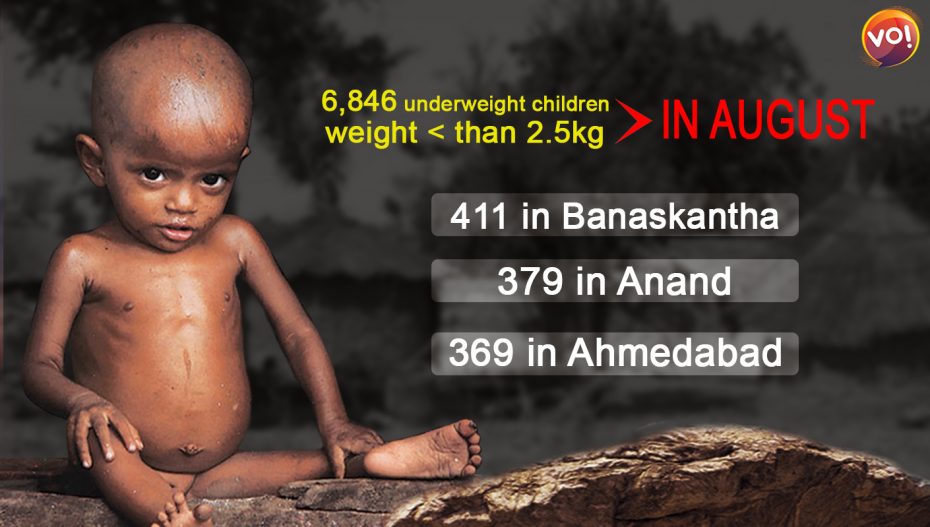The dispensation that rules India claims Gujarat is a promised land of plenty and a model to emulate but the state’s abysmal record in child health stands in stark contrast to those big boasts.
Ask Feriyal Suran, an auxiliary nurse midwife from Ahmedabad — and not some remote corner of Gujarat — if she often sees malnourished children and she recalls a severely underweight 8-month-old dying in front of her last month.
Last month, 6,846 underweight children — weighing less than 2.5kg — were born in Gujarat. The total number of anaemic children born during the same period in the state was 802. Among the districts, Banaskantha logged the highest number of underweight newborns with 411 cases, followed closely by Anand (379) and Ahmedabad city (369).
Kheda and Kutch recorded 289 and 265 cases respectively, while Rajkot had 260 cases.
Gandhinagar, the best faring district, logged the fewest cases of underweight newborns (11), according to data released by the state health authorities.
Banaskantha, with a large rural population, a considerable tribal population, and some nomadic tribes, also recorded the highest number of child anaemia cases, 239. Ahmedabad had 24 newborns with anaemia.
These are official numbers, and questions have earlier been raised on the state’s data. The Comptroller and Auditor General of India (CAG) had accused the Gujarat government of using methodologies generally not used by the World Health Organisation (WHO) or the National Family Health Survey (NFHS) to show fewer numbers.
In a report tabled in 2018, the CAG held that the state government was considering only underweight children to assess malnutrition levels. The levels of stunting and wastage, extremely important indicators to consider while calculating malnutrition, were conspicuously missing from the state’s numbers.
A UNICEF report, Rapid Survey on Children (RSOC), had in 2013-14 stated that Gujarat was the only developed state which had malnutrition worse than the national average.
In a 2012 interview with The Wall Street Journal, then Gujarat chief minister Narendra Modi had, of course, famously blamed the people for the state’s abysmal performance in health indices, by saying: “The middle class is more beauty-conscious than health-conscious and that is a challenge.”
That comment had come in the wake of NFHS-3 finding that over 41 per cent of children in Gujarat under three years of age were underweight, much worse than the national average.
The then Gujarat chief minister has now become Prime Minister of India, but the state’s children have not seen acchhe din. Gujarat is still ranked fifth-worst in parameters judging malnutrition and child anaemia.
State-wise bifurcation – https://www.datawrapper.de/_/4NVZx/
National surveys, state shame
As per NFHS-5 findings, Gujarat and Bihar were the worst performers in tackling acute malnutrition. Incidentally, both states have had the same party ruling for a very long time, apart from Nitish Kumar’s brief dalliance with Lalu Prasad.
In 2018, Gujarat infant mortality rate — the number of children dying per 1,000 live births — was 28 while the national figure was 32. In 2019-2020, the state had an under-five mortality rate of 37.6 per 1,000 live births, much higher than the national average of 34.3 — according to UNICEF data.
According to the NFHS-5 data, 39 per cent of children under the age of 5 in Gujarat are stunted, up from 38.5 per cent in 2015-16.
In 2019-2020, 10.6 per cent of children in Gujarat were severely wasted, up from NFHS-4’s 9.5 per cent.
The percentage of underweight kids — 39.7 per cent — was also marginally (0.3 per cent) higher than what it was five years back during NFHS-4.
Covid worsens scenario
Experts believe that the pandemic, too, has played a role in rising levels of malnutrition in the state.
“During the pandemic anganwadi centres were shut, which was a big mistake,” said activist Sejal Dand, executive director, ANANDI. “The government should have registered the anganwadis under essential services. Also, the Integrated Child Development Scheme (ICDS) requires supplementary budget allocation. The government should ensure that every child is well-fed. That is only when we will be able to arrest the growing bane of malnutrition.”
Dand also pointed that, unlike other states, school mid-day meals in Ahmedabad do not have eggs – a high source of protein – which brings down the nutritional value of the food served. “Gujarat has a large migrant population and they have eggs in their diet,” Dand added. “Serving dal, rice and other pulses just won’t cut it.”












